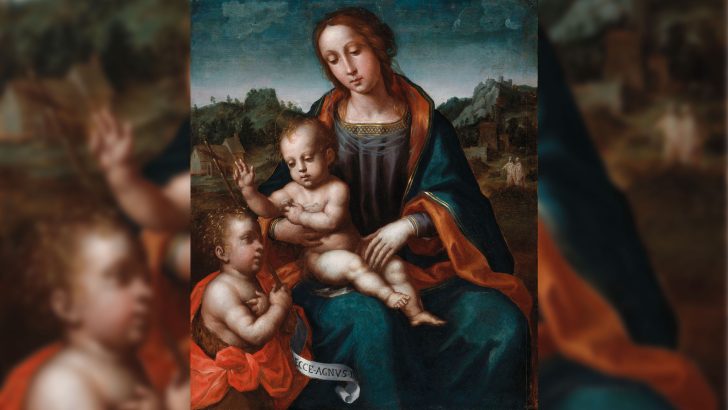Christ and His Cousin: Renaissance Rediscoveries, curated by Dr Aoife Brady
(Continues to 8 May 2022; Hugh Lane Room; free admission – no booking required)
Currently the National Gallery is running a small but very interesting show in one of their smaller exhibition spaces focused on images of the child Jesus and his cousin St John the Baptist.
These have taken the gallery’s head of conservation Simone Mancini some 15 years to conserve. Over the decades some of these have been hardly seen at all; but changing interests in art history have now greatly added to their interest, and the opportunity to see the paintings should be seized.
They and their scholarly presentation will greatly interest those concerned with the expression of faith in the Renaissance and Counter-Reformation.
There are eight images in all, the finest of which is by general agreement that by Giovanni Antonio Sogliani, The Virgin and Child with Saint John the Baptist. Here a pensive Madonna watches the interaction of the two children, Jesus with a hand raised in blessing, the infant John grasping a reed (symbolic of his future staff from the banks of the River Jordan}, which is alluded to on the top left of the background. In the back on the right can be seen in the distance two figures in white thought to represent the adult Jesus and John walking together.
This painting focuses on two things: the prophetic soul of the Virgin Mary contemplating the distant pain that is in store for all three, and how the present joys of childhood will give way to the sterner demands to be made on them in later years.
This theme can be seen in the other painting illustrated here, thought to be by Jacopino del Conte, though not as well expressed. But all of them give glimpses of family life in Renaissance Florence, then centre of Italian culture, which are very charming and delightful in themselves.
All these images are the work of Florentine painters. The devotion to St John the Baptist, seen as the forerunner of the Messiah to come, was very important in the city then. John the Baptist was the patron saint of the city, the original patron of the city being St Anne, the mother of the Blessed Virgin. So there was widespread devotion in Florence to these figures, and the feastday of his nativity on June 24, placed to balance with the nativity of Jesus, was the occasion for elaborate city-wide summer festivities.
Bourgeoisie
The pictures on show were probably not, from their size, intended for great churches, religious houses, or rich convents, but for the homes of middling prosperous Florentine bourgeoisie. The gallery is rich in images that come from those other institutions; these come from the private domestic scene, they represent the familial piety of ordinary people. Hence the warm and playful family life that they depict.
The traditional echoes in these images (and indeed in much religious art down to modern times) comes not so much from the Gospel narratives of the New Testament with echoes from Old Testament prophesies, as from the rich apocalyptic tradition, so important in Catholic folklore.
Dr Aoife Brady says Christ and His Cousin: Renaissance Rediscoveries “will explore the symbolism and traditions that underpin these playful and lively compositions, and encourage visitors to reconsider what are often dismissed as conventional and familiar images”.
The traditions behind these images come not from the Gospels themselves, but from beliefs generated from passages in the Old Testament prophets and the early Christians recorded in the early non-canonical apocrypha, such as the Gospel of James. Some of these books survive in the Catholic Bible, but are excluded from those of the reformed traditions.
Much of this and more was given form by Jacobus de Voraigne (1230-1298), the Archbishop of Genoa. His compilation The Golden Legend (circa 1260) was one of the most influential books of the age, and its notions lingered on in the sort of things told to Catholic children by the nuns who began their education. Now the wondrous folklore of the high middle ages has largely evaporated; yet its notions can be seen everywhere in European art, especially in the kind of devotional paintings to be seen in this exhibition. An encounter with these paintings will open up for many unfamiliar aspects of their heritage.
(Those who wish to learn more about what critical use can be made of these traditions should consult The Legends of the Saints by the Bollandist Hippolyte Delehaye (Four Courts Press, Dublin 1991), a modern edition with a new introduction by the Dublin-born expert in this field, Fr Thomas O’Loughlin, professor emeritus of Historical Theology at Nottingham University.)
And while they are in the National Gallery visitors should explore the nearby rooms which are crowded with examples of religious art from the Renaissance and other periods. No matter how familiar we think we are with the collection there will always be unfamiliar images to catch our attention and open up new experiences for eye and imagination.


 Peter Costello
Peter Costello Giovanni Antonio Sogliani, The Virgin and Child with Saint John the Baptist, 1620-1630. Oil on panel, NGI.4089. Photo: © National Gallery of Ireland
Giovanni Antonio Sogliani, The Virgin and Child with Saint John the Baptist, 1620-1630. Oil on panel, NGI.4089. Photo: © National Gallery of Ireland 